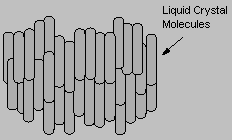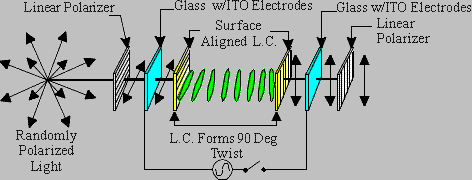
Basics of LCD Operation
Liquid crystal displays (LCDs) are a passive display
technology. This means they do not emit light; instead, they use the ambient
light in the environment. By manipulating this light, they display images
using very little power. This has made LCDs the preferred technology
whenever low power consumption and compact size are critical.
Liquid crystal (LC) is an organic substance that has both a liquid form and
a crystal molecular structure. In this liquid, the rod-shaped molecules are
normally in a parallel array, and an electric field can be used to control
the molecules. Most LCDs today use a type of liquid crystal called Twisted
Nematic (TN). See figure below to see a visual of the molecule alignment.

A Liquid Crystal Display (LCD) consists of two substrates that form a "flat
bottle" that contains the liquid crystal mixture. The inside surfaces of the
bottle or cell are coated with a polymer that is buffed to align the
molecules of liquid crystal. The liquid crystal molecules align on the
surfaces in the direction of the buffing. For Twisted Nematic devices, the
two surfaces are buffed orthogonal to one another, forming a 90 degree twist
from one surface to the other, see figure below.

This helical structure has the ability to control light. A polarizer is
applied to the front and an analyzer/reflector is applied to the back of the
cell. When randomly polarized light passes through the front polarizer it
becomes linearly polarized. It then passes through the front glass and is
rotated by the liquid crystal molecules and passes through the rear glass.
If the analyzer is rotated 90 degrees to the polarizer, the light will pass
through the analyzer and be reflected back through the cell. The observer
will see the background of the display, which in this case is the silver
gray of the reflector.
The LCD glass has transparent electrical conductors plated onto each side of
the glass in contact with the liquid crystal fluid and they are used as
electrodes. These electrodes are made of Indium-Tin Oxide (ITO). When
an appropriate drive signal is applied to the cell electrodes, an electric
field is set up across the cell. The liquid crystal molecules will rotate in
the direction of the electric field. The incoming linearly polarized light
passes through the cell unaffected and is absorbed by the rear analyzer. The
observer sees a black character on a sliver gray background, see figure 2.
When the electric field is turned off, the molecules relax back to their 90
degree twist structure. This is referred to as a positive image, reflective
viewing mode. Carrying this basic technology further, an LCD having multiple
selectable electrodes and selectively applying voltage to the electrodes, a
variety of patterns can be achieved.

Many advances in TN LCDs have been produced. Super Twisted Nematic (STN)
Liquid Crystal material offers a higher twist angle (>=200° vs. 90°) that
provides higher contrast and a better viewing angle. However, one negative
feature is the birefringence effect, which shifts the background color to
yellow-green and the character color to blue. This background color can be
changed to a gray by using a special filter.
The most recent advance has been the introduction of Film compensated Super
Twisted Nematic (FSTN) displays. This adds a retardation film to the STN
display that compensates for the color added by the birefringence effect.
This allows a black and white display to be produced.